Science
A Is for Atom PSA
Dr. Atom is a hideous abomination of nightmare fuel.
Posted By: Paul - Wed Nov 29, 2017 -
Comments (2)
Category: PSA’s, Science, 1950s
Circulatory effects of trumpet playing
"Circulatory Effects of Trumpet Playing" (British Medical Journal - 1959) details a self-experiment by a professional trumpet player to determine the best position in which to play the trumpet to avoid blacking out while playing high loud notes. He determines that laying down flat offers the most blackout protection.Another curious detail from the article: his suggestion that trumpeters in orchestras could avoid blackout by wearing pressure suits "which could be surreptitiously inflated by a switch on the conductor's desk."
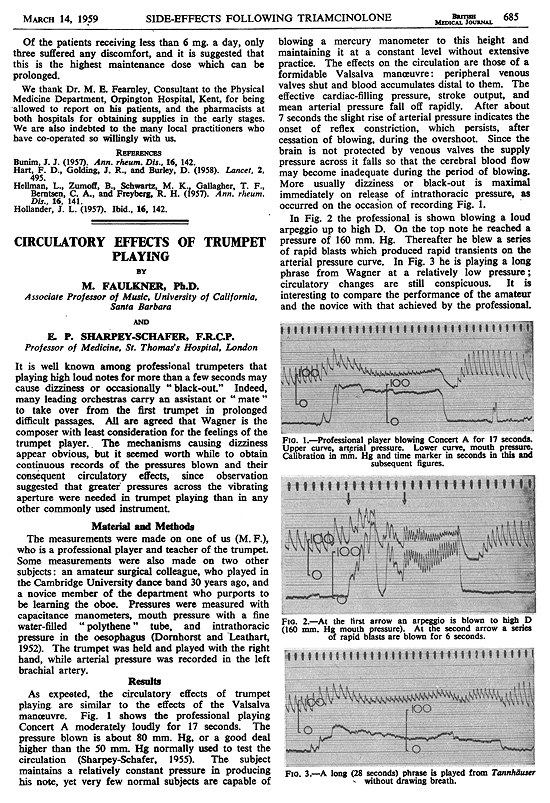
Apart from the discomfort of occasional dizzy sensations or black-outs, trumpet players are not likely to come to any harm. Vasodilation from heat or previous hyperventilation will exaggerate the effects of a given intrathoracic pressure. It is better to sit than stand, but the strict supine posture, which would be better still, seems hardly feasible. For orchestras in severe financial difficulties it might be possible to dispense with the assistant or 'mate' if the trumpeter wore a pilot's pressure-suit, which could be surreptitiously inflated by a switch on the conductor's desk.
Posted By: Alex - Tue Nov 28, 2017 -
Comments (3)
Category: Music, Science
Naked Chicken Research
1976: Drs. William Johnson and Robert Truax of Louisiana State University raised and studied featherless chickens."I guess 'embarrassed' is as good a word for it as any. You put one of them in with a flock of normal birds, and it huddles off in a corner by itself. The other birds won't have anything to do with it until they get used to it," he said.
"And then they're just not as active sexually. They will court and strut much more than the normal bird, but they don't mate as readily."
The story reminds me of the old urban legend about KFC raising mutant, featherless chickens. Maybe this is where the story started.

Argus Leader - Aug 31, 1976

Salisbury Daily Times - Aug 31, 1976
Posted By: Alex - Fri Sep 29, 2017 -
Comments (4)
Category: Animals, Science, Psychology, 1970s
Lloyd Thomas Koritz — Human Guinea Pig
As a young doctor-in-training at the University of Illinois Medical School in the early 1950s, Lloyd Thomas Koritz volunteered to be a guinea pig in a variety of experiments. In one, he ate a pound of raw liver daily (washed down by a quart of milk) to help study liver metabolism. In a fatigue study he was kept unconscious for 11 hours.But the most dangerous experiment involved being hung in a harness from a specially-constructed mast and knocked out with anesthesia and curare, so that his breathing stopped. Researchers then tested methods of resuscitating him. They were searching for more efficient ways of resuscitating electrocuted power line workers, so that they could revive the workers while they were still hanging from the poles instead of having to lower them while unconscious to the ground, which takes a lot of time.
I think it would be hard nowadays to get approval to do these kinds of tests on human subjects. Koritz said he disliked the liver-eating experiment the most. In 1953 he was given the Walter Reed Society Award for being willing to repeatedly risk his life for the sake of science.

"Drugged into unconsciousness and paralysis, [Koritz] willingly risked insanity
and death in a significant experiment. This test helped determine the best way
to revive electrically-shocked linemen."
Saturday Evening Post - July 25, 1953

San Bernardino County Sun - Apr 9, 1953

San Bernardino County Sun - Apr 9, 1953
Posted By: Alex - Tue May 23, 2017 -
Comments (8)
Category: Science, Experiments, 1950s
The Drivometer
A device for simulating driving, and measuring the skill of drivers, which was developed at Iowa State's Driving Research Laboratory in the 1930s.
A description of what it felt like to operate the thing. It sounds like it would have made a good arcade game. From The Dalles Chronicle - Aug 21, 1936:
Update: I think the top picture shows the 2nd version of the Driveometer, developed in the 1950s. The original version, from the 1930s, is below.

Wausau Daily Herald - Oct 26, 1937
Posted By: Alex - Tue May 09, 2017 -
Comments (4)
Category: Motor Vehicles, Cars, Science, 1930s
Obese, the Freak Fat Mouse
A fat mouse that was bred at Jackson Laboratory in Bar Harbor, Maine during the late 1940s/early 1950s. The researchers called him "Obese," or "O.B." for short. As in, that was his name, not just a description of what he was. Fat mice bred from Obese were used in the study of diabetes and obesity.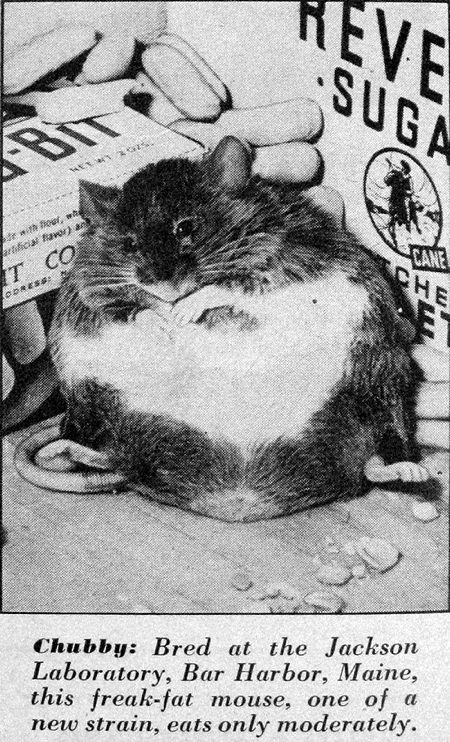
Newsweek - Apr 2, 1951
Ellen Ruppel Shell tells the story of Obese in her book The Hungry Gene: The Inside Story of the Obesity Industry:
An animal caretaker first spotted the creature huddled in a corner of its cage, grooming itself. It was furrier than most, but what really stood out was the size of the thing — it was hugely fat. The caretaker alerted doctoral candidate Margaret Dickie, who diagnosed the mouse as "pregnant." But there were problems with this theory. For one thing, the mouse never delivered a baby. And on closer inspection, it turned out to be male. The fat mouse ate three times the chow eaten by a normal mouse, pawing for hours at the bar of the food dispenser like an embittered gambler banging away at a recalcitrant slot machine. Between feedings it sat inert. It seemed to have been placed on this earth for no other purpose than to grow fat.
There had been other fat mice. The agouti mouse, named for its mottled yellow fur similar to that of the burrowing South American rodent, is, in its "lethal yellow" mutation, double the weight of the ordinary variety. But the fat agouti was svelte compared to the newcomer. This mouse was outlandish, a joke, a blob of fur splayed out on four dainty paws like a blimp on tricycle wheels. Rather than dart around the cage in mousy abandon, it was docile, phlegmatic, as though resigned to some unspeakable fate. Dickie and her colleagues christened the mouse "obese," later abbreviated to "ob," and pronounced "O.B.," each letter drawn out in its own languid syllable.
Posted By: Alex - Mon May 08, 2017 -
Comments (2)
Category: Animals, Science, 1940s, 1950s
Historic Book Odour Wheel
Noting that "the role of smells in how we perceive heritage has not been systematically explored until now," researchers at University College London have developed a "Historic Book Odour Wheel."They tested it on visitors to St Paul's Cathedral's Dean and Chapter library in London, who characterized the smell of the library as 'woody,' 'smoky,' 'earthy,' and 'vanilla.'
The researchers say, "the Historic Book Odour Wheel could potentially be used to recreate smells and aid the design of olfactory experiences in museums, allowing visitors to form a personal connection with exhibits by allowing them to understand what the past smelled like."
More info: Science Daily, Heritage Science
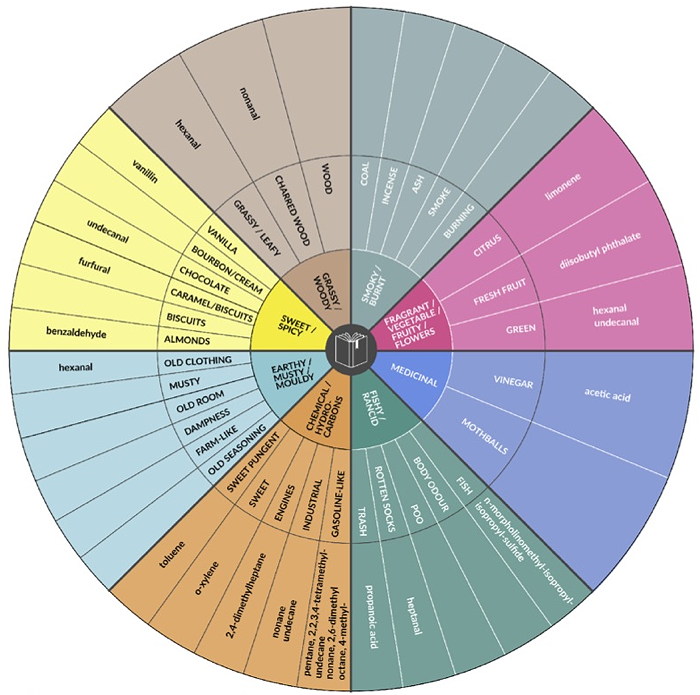
Posted By: Alex - Wed Apr 12, 2017 -
Comments (3)
Category: Science, Books, Perfume and Cologne and Other Scents
Operation Fragrant Cow
Back in the 60s, the U.S. Army employed scientists to sneak into Omaha stockyards and spray cows with deodorant. The logic behind this was to test how easy it would be for Soviet agents to spread hoof-and-mouth disease among American cows.Unfortunately, I can't find any more info about this operation, which is a shame because it raises so many questions. For instance, the important part of the operation must have been to see how easily they could gain access to the stockyards. So then, why bother to deodorize the cows? Was it just to add a touch of realism? Why not spray them with paint so that they could later count the "infected" ones?
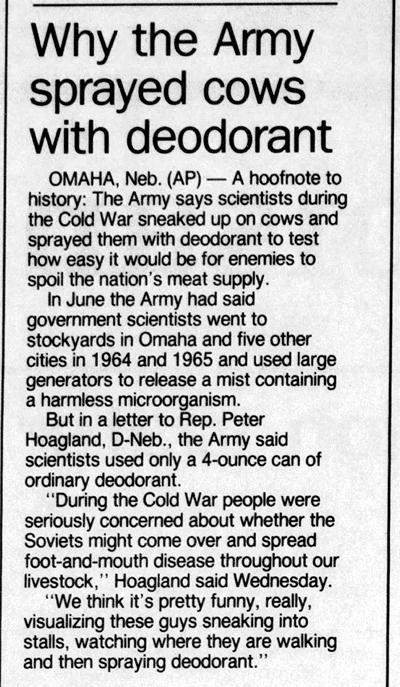
Southern Illinoisan - Aug 5, 1994
Posted By: Alex - Sun Apr 09, 2017 -
Comments (2)
Category: Military, Science, Cows, 1960s
Controlling Turtle Motion with Human Thought
Researchers in Korea are developing a technology that will allow humans to control turtles through thought alone. This is achieved without having to implant any device inside the turtle's brain. Nor does it involve telekinetic powers.It takes advantage of the fact that a turtle will reliably walk towards a white light, because of their instinctive escape behavior. So the turtle wears a "stimulation device" that blocks its view except in a specific direction that can be remotedly adjusted by a human wearing a "brain-computer interface." The interface can pick up simple thought commands: left, right, or idle. It then transmits the command to the turtle stimulation device, which adjusts its position, and the turtle walks in the desired direction.
The researchers note that their system "could have military applications such as reconnaissance and surveillance," and also "this system could be used in unconventional applications such as immersive virtual reality systems that give the user a sense of oneness with the controlled animal, as if it were their surrogate agent."
More info: Science Daily

Posted By: Alex - Sat Apr 01, 2017 -
Comments (5)
Category: Animals, Science, Experiments
Cockroach Magnetization
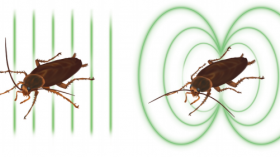
Researchers at Nanyang Technological University in Singapore recently made an unusual discovery, which is that "the magnetic properties of living cockroaches are strikingly different from those of dead cockroaches."
Place a living cockroach in a magnetic field and it'll become magnetized, and then stay magnetized for about 50 minutes.
Place a dead cockroach in a magnetic field and it'll also become magnetized, but then remain magnetized for almost 50 hours.
The reason for the difference:
So I'm curious how strongly magnetized dead cockroaches become. Would it be possible to use them as refrigerator magnets?
More info: MIT Technology Review
Posted By: Alex - Tue Feb 28, 2017 -
Comments (5)
Category: Insects and Spiders, Science, Experiments

| Who We Are |
|---|
| Alex Boese Alex is the creator and curator of the Museum of Hoaxes. He's also the author of various weird, non-fiction, science-themed books such as Elephants on Acid and Psychedelic Apes. Paul Di Filippo Paul has been paid to put weird ideas into fictional form for over thirty years, in his career as a noted science fiction writer. He has recently begun blogging on many curious topics with three fellow writers at The Inferior 4+1. Contact Us |




